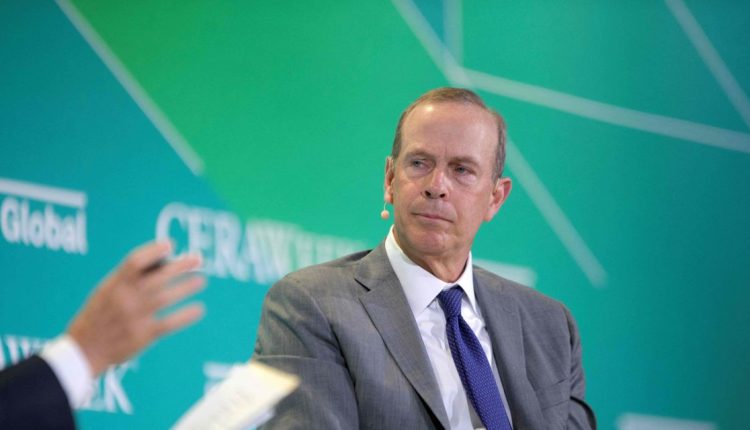Oil prices charted fresh intraday highs for the year on Tuesday, but settled slightly lower for the session.
U.S. and global benchmark crude prices eased back, after expectations of tighter oil supplies fed a three-session run up to the highest prices since November. Chevron CEO Mike Wirth, meanwhile, predicted prices will return to $100 a barrel.
Price action
-
West Texas Intermediate crude
CL00,
+0.07%
for October delivery
CL.1,
-0.04% CLV23,
-0.04%
fell 28 cents, or 0.3%, to settle at $91.20 per barrel on the New York Mercantile Exchange after trading as high as $93.74. On Monday, oil ended at $91.48, the highest front-month contract finish since Nov. 7, based on Dow Jones Market Data. -
November Brent crude
BRN00,
+0.14% BRNX23,
+0.14% ,
the global benchmark, edged down by 9 cents, or 0.1%, to settle at $94.34 a barrel after a high of $95.96 on ICE Futures Europe. Monday’s close of $94.43 a barrel was the highest since Nov. 11. -
October gasoline
RBV23,
-1.22%
fell 1.5% to $2.66 a gallon, while October heating oil
HOV23,
+3.22%
added 2.6% to $3.37 a gallon. -
October natural gas
NG00,
+3.85% NGV23,
+3.85%
settled at $2.85 per million British thermal units, up 4.4%.
Market drivers
“Oil trading is a sophisticated game of Chutes & Ladders” and there are some hot spots that may take Brent, and possibly WTI, to $100 a barrel shortly, said Tom Kloza, global head of energy analysis at the Oil Price Information Service, a Dow Jones company.
But whether either benchmark can average $100 for a month is “an interesting question,” he said. “When there are bullish extremes in sentiment, it is often a sign that the market is about to turn.”
Investors have been looking past worries about China’s economic growth and a sluggish economy in Europe to push the commodity higher amid ever-tightening supplies, as Russia and Saudi Arabia have each curbed production. U.S. oil prices gained 3.7% last week and Brent 3.6%, with both also ending Friday and Monday at their highest since November.
“The Saudi appetite to withhold oil from market, supported by Russia maintaining a certain level of export constraint, points to higher prices in the short term, all else equal,” analysts at Citi, led by Edward Morse, global head, commodities, wrote in a note dated Monday.
However, $90 prices “look unsustainable given faster supply growth than demand growth,” excluding Saudi Arabia and Russia, they said. “Higher prices in the near term could make for more downside for prices next year.”
The biggest threats to the oil rally continuing are “changes in fundamentals,” said Troy Vicent, senior market analyst at DTN.
“At current price levels, a diminished appetite for crude imports by China and rising Chinese product exports are the most likely culprits to help cool off this rally in the near term,” he told MarketWatch. “If this materializes, and particularly if we start to see demand slow elsewhere, it could quickly change the Saudi’s calculus on how far they’re willing to push their voluntary supply cuts.”
Over in the U.S., the monthly domestic drilling report from the Energy Information Administration released Monday showed expectations for a fall of 40,000 barrels per day in oil production production from seven major U.S. shale plays in October to 9.393 million barrels a day.
That would be the largest month on month drop since December 2022, StoneX’s Kansas City energy team, led by Alex Hodes, wrote in Tuesday’s newsletter.
Meanwhile, Chevron Corp.
CVX,
CEO Wirth told Bloomberg TV in an interview on Monday that crude looks likely to reach $100 per barrel, a level it hasn’t seen in more than a year. “Supply is tightening, inventories are drawing. These things happen gradually and you can see it building, and so I think…the trends would suggest that we’re certainly on our way,” he said.
Wirth acknowledged that oil at $100 could cause a “drag” on the U.S. and global economies, as some market observers are fearing.
“But you know, we’ve had relatively higher oil prices here now for most of this year and certainly all of last year. The recession that everyone’s been talking about hasn’t arrived. And so I think the underlying drivers of the economy in the U.S. and frankly globally remain pretty healthy,” he said.
Wirth said they haven’t changed their long-term price expectations for oil, though noted the market has been volatile since the pandemic. “This has been a period of time where prices have been unpredictable and volatile and not what you would call midcycle,” he said.
Read the full article here

